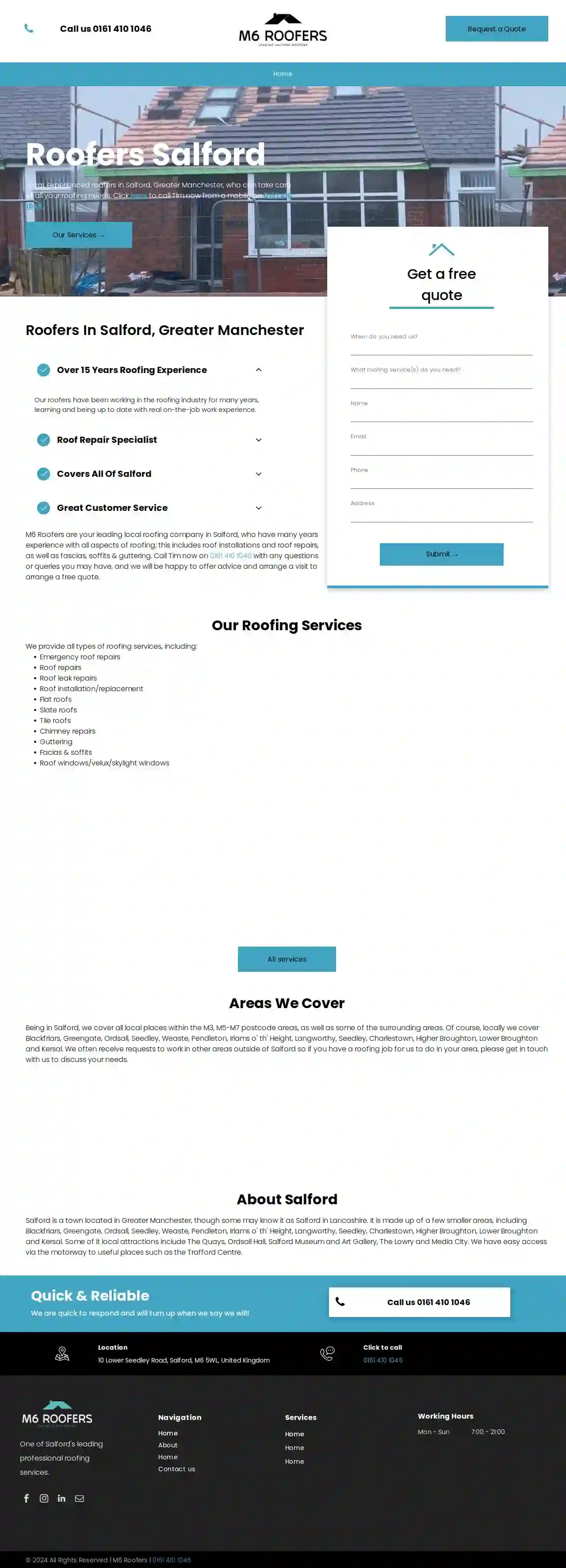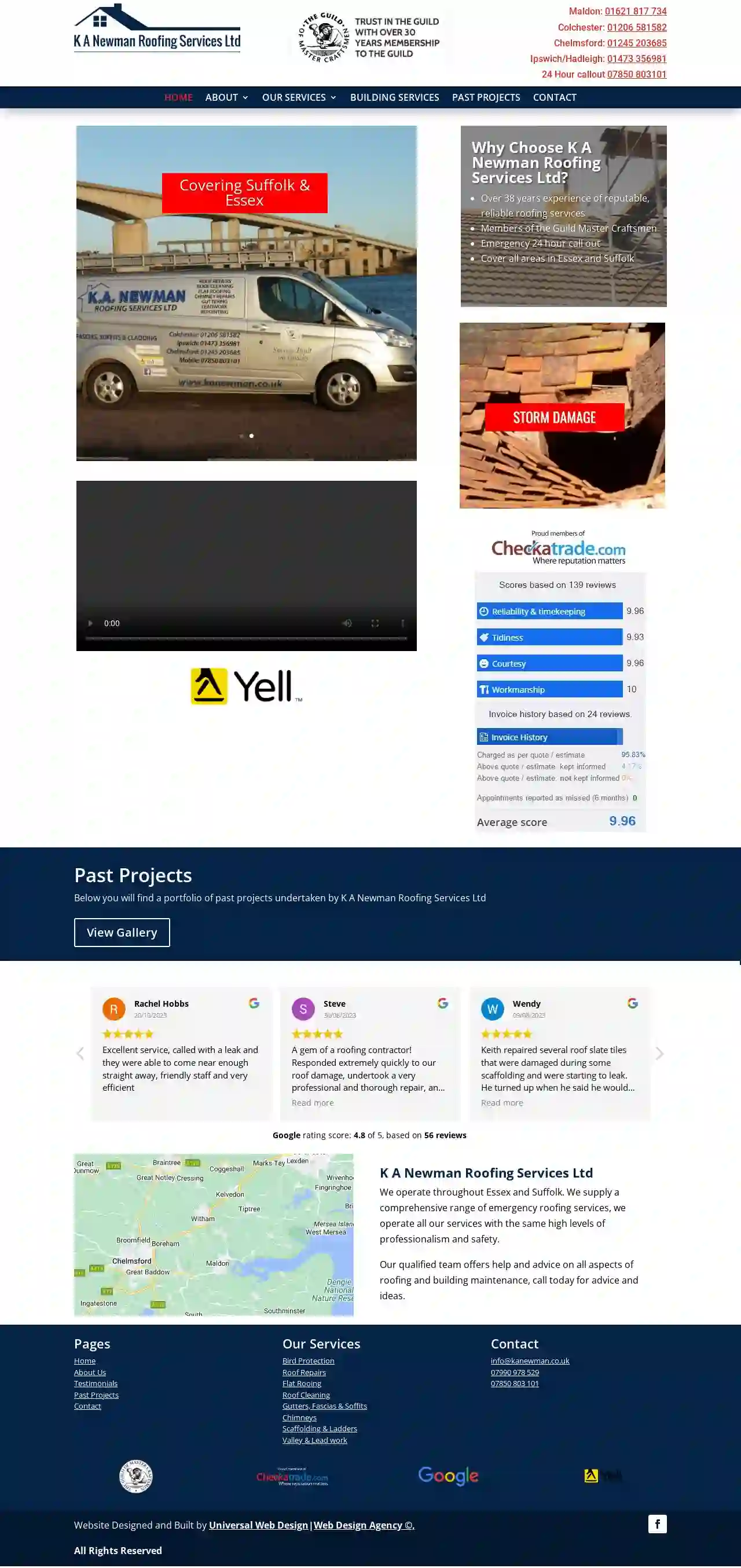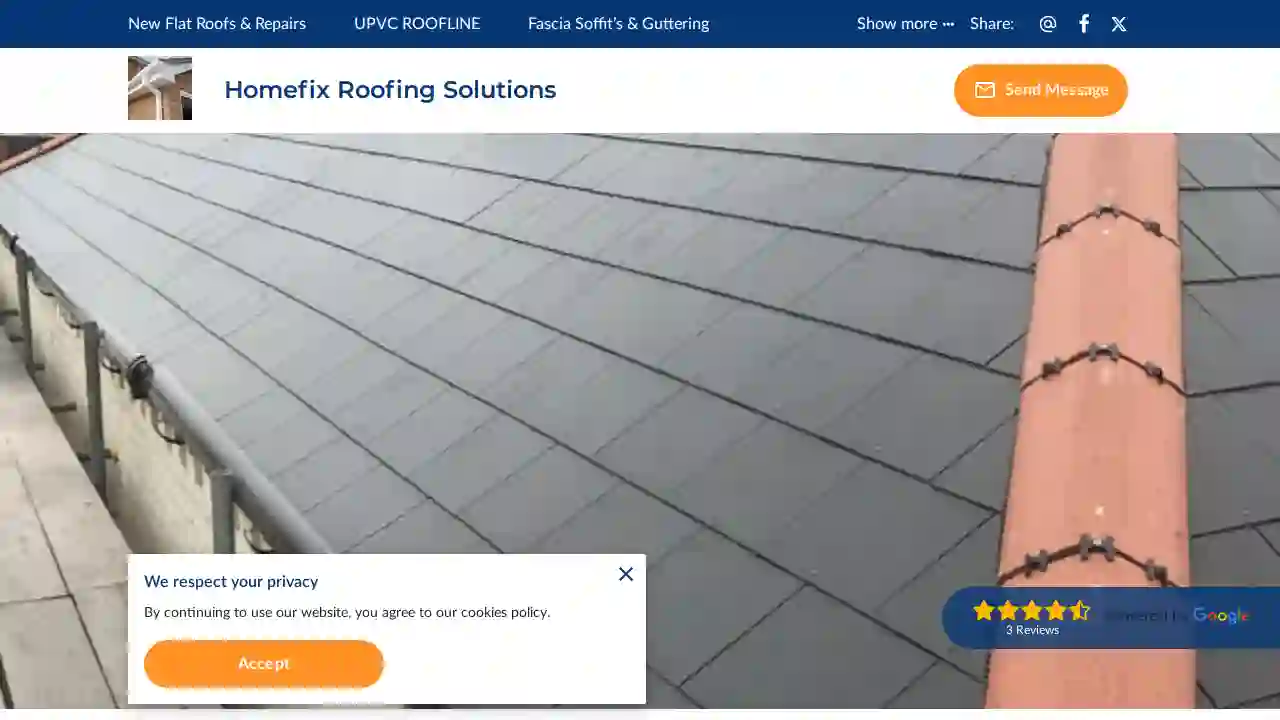Roof Leak Repair Rochdale
Best Roof Leak Repair in Rochdale
Receive up to 3 Roof Leak Repair quotes for your project today! Compare profiles, reviews, accreditations, portfolio, etc... and choose the best service.

LAB Roofing Services
GBLAB Roofing Services is a trusted and professional roofing contractor serving Birmingham and the West Midlands. With a wealth of experience in the industry, we pride ourselves on delivering high-quality roofing solutions to both commercial and domestic clients. Whether you require a new roof, repairs, or any other roofing service, our team of certified experts is here to help. We offer a wide range of services, including new roofs, flat roofing, lead work, roof surveys, roof ventilation, chimney repoints, fascias and soffits, GRP roofing, guttering and downpipes, single ply roofing, slate and tiling, Velux, EPDM rubber roofing, and pest control for solar panels. At LAB Roofing Services, we understand the importance of providing our clients with exceptional service and value. We are committed to delivering fair prices, flexible scheduling, and a hassle-free experience. Contact us today for a free, no-obligation quote and let us take care of all your roofing needs.
- Services
- Why Us?
- Gallery
Get Quote
M6 Roofers
55 reviews10 Lower Seedley Road, Salford, M6 5WL, GBM6 Roofers are your leading local roofing company in Salford, who have many years experience with all aspects of roofing; this includes roof installations and roof repairs, as well as fascias, soffits & guttering. We provide all types of roofing services, including emergency roof repairs, roof repairs, roof leak repairs, roof installation/replacement, flat roofs, slate roofs, tile roofs, chimney repairs, guttering, facias & soffits, and roof windows/velux/skylight windows. Our roofers have been working in the roofing industry for many years, learning and being up to date with real on-the-job work experience. We are based in M6 Salford, and work here and all surrounding Salford areas, including Seedley, Irlams o' th' Height, Higher & Lower Broughton, Worsley and Wardley. We provide a high quality yet easy personable experience, and are quick to respond and will turn up when we say we will!
- Services
- Why Us?
- Gallery
Get Quote
Best Rated Roofers
4.47 reviewsOak Compass Road Pattiswick Braintree Essex, Braintree, CM77 8BG, GBBest Rated Roofing Ltd is a local, trusted roofing installation and repair company covering Essex and the surrounding areas. Our team of roofers has many years’ experience within the roofing industry and we are fully qualified and insured in all aspects of domestic, commercial and industrial roofing. From a simple roof repair to a complete re-roof, replacement flat roof or fascias, soffits and guttering, you will receive a free, no-obligation survey, a written quotation and a service that will leave you completely satisfied with the work carried out and, guess what, its all fully guaranteed!
- Services
- Why Us?
- Gallery
Get Quote
AKH Roofing LTD
511 reviewsGBAKH Roofing Ltd are a family run roofing company with many years of knowledge and experience. We are based in Suffolk; however we also cover Cambridgeshire, Norfolk and Essex. We are able to take on all aspects of roofing from the sole plate up. This makes us different from many other roofing contractors. Our passion is Roof restoration/heritage work. But we also take on many new build properties and roof repairs. We are equipped for all types of roofing and roof carpentry at a competitive rate. We pride ourselves on attention to detail and going the extra mile for our clients.
- Services
- Why Us?
- Gallery
Get Quote- Ha
Hallsworth Thatching
51 reviewsBury, GB- Services
- Why Us?
- Gallery
Get Quote 
K A Newman Roofing Services Ltd
4.855 reviewsBury, GBK A Newman Roofing Services Ltd is a reputable and reliable roofing company with over 38 years of experience. We operate in Essex and Suffolk, covering all areas, and offer a comprehensive range of roofing services. Our team of qualified professionals provides help and advice on all aspects of roofing and building maintenance. We are members of the Guild Master Craftsmen and offer an emergency 24-hour call-out service. Our services include bird protection, roof repairs, flat roofing, roof cleaning, gutters, fascias, and soffits, chimneys, scaffolding, and ladders, and valley and lead work. We have a portfolio of past projects and a team of experts who are dedicated to providing excellent customer service.
- Services
- Why Us?
- Our Team
- Testimonials
- Gallery
Get Quote
A-Class Roofing & Construction Ltd
4.840 reviews17 Harnham Trading Estate, Salisbury, SP2 8NW, GBA-Class Roofing & Construction is a Salisbury-based roofing company that provides a comprehensive range of roofing services, including installations, repairs, and maintenance. Established in 2008, the company prides itself on its commitment to quality craftsmanship, customer satisfaction, and competitive pricing. They offer a 25-year guarantee on all their work. Simon, the founder, has a lifelong experience in the roofing trade and leads a team dedicated to delivering projects that meet the exact specifications of their clients. A-Class Roofing serves both residential and commercial clients in Salisbury and across Wiltshire.
- Services
- Why Us?
- Our Team
- Testimonials
- Gallery
Get Quote
Mark Game Roofing Contractor Ltd
51 reviewsSalisbury, Wiltshire, Office, SP1 2PB, GBMark Game Roofing Contractors Ltd is the south's premier roofing company, providing roofing services to local builders, small to large building developers, residential home owners and commercial property owners. We are based in Salisbury, Wiltshire and provide roofing services to surrounding counties of Hampshire, Dorset, Somerset, Gloucestershire, Oxfordshire and Berkshire. Our staff are skilled in the Roofing industry and specialise in the renovation / refurbishment and maintenance of conservation / heritage and listed building / period buildings. We offer a range of roofing services, including new roofs, re/roofs, roofing repairs, leadwork, shingle roofs, chimney repointing and removal, and flat roofs from felt, Firestone rubbercover, rutivex single ply membrane and green roof systems. All of our roofing services come with a 10 year insurance backed guarantee.
- Services
- Why Us?
- Accreditations
- Our Team
- Testimonials
- Gallery
Get Quote
H20 roofing and building ltd
N/A, GBH2O Property Maintenance is a family-run, recommended and vetted business with over 25 years of experience in providing reliable roofing and building solutions. We pride ourselves on delivering high-quality workmanship and customer satisfaction, ensuring your roofing needs are met first time, every time. Our team of expert roofers are professionally trained to meet the highest quality standards and provide tailor-made solutions accredited by leading manufacturers. We offer a comprehensive range of services, including roof repairs, flat roof installations, guttering and fascia services, Velux roof windows, moss removal, exterior painting, and chimney services. We use top-quality materials from well-known manufacturers and guarantee our work. We are committed to providing cost-effective solutions and a stress-free experience for our clients.
- Services
- Why Us?
- Accreditations
- Our Team
- Testimonials
- Gallery
Get Quote
HomeFix Roofing Solutions
4.73 reviews2 Northgate Avenue, Bury Saint Edmunds, IP32 6bb, GBHomefix Roofing Solutions is your local expert for all your roofing and guttering needs in Bury Saint Edmunds and the surrounding areas. We pride ourselves on delivering high-quality workmanship, competitive prices, and exceptional customer service. Whether you require a small repair, a complete new roof, or anything in between, our dedicated team of roofers is here to help. We offer a comprehensive range of services, including new flat roofs, UPVC roofline, fascia and soffit installation, chimney brick repairs, and more. We are committed to using the latest building regulations and techniques to ensure all projects are completed safely and to the highest standards. Our reputation for reliability and customer satisfaction is built on years of experience and a genuine passion for providing excellent service. Contact us today for a free quote and let us take care of your roofing needs.
- Services
- Why Us?
- Accreditations
- Our Team
- Testimonials
- Gallery
Get Quote
Over 12,314+ Roofers on our directory
Our roofing pros operate in Rochdale & beyond!
Roofyng.co.uk has curated and vetted Top Roofing Contractors arround Rochdale. Find a trustworthy contractor today.
Roof Leak Repair FAQs
- Water Damage: The leak will worsen, causing damage to ceilings, walls, insulation, and even structural components like rafters and joists.
- Mold Growth: Moisture buildup from leaks creates an ideal environment for mold growth, posing health risks and further damaging your home.
- Increased Energy Bills: Damaged insulation from leaks reduces energy efficiency, increasing your heating and cooling costs.
- Decreased Property Value: A leaky roof detracts from your home's value and can make it difficult to sell.
- Safety Hazards: In severe cases, water damage can weaken the roof structure, potentially leading to a collapse.
- Accurate diagnosis of the cause.
- Proper and lasting repair.
- Prevention of future, costlier problems.
- Maintaining your roof's warranty validity.
- Start in the Attic: Go into your attic during daylight and look for signs of water damage, like water stains, damp insulation, or mold.
- Follow the Trail: Follow any visible water stains or dampness upward to trace the leak's path.
- Inspect the Roof: From the outside, carefully inspect your roof for missing, damaged, or curled shingles, gaps in flashing, cracks around vents or chimneys, or any other visible damage.
- Check for Penetrations: Pay close attention to areas where objects penetrate the roof, such as vent pipes, chimneys, skylights, and dormers, as these are common leak points.
- Consider a Water Test: If the leak is elusive, a roofing contractor can perform a water test, spraying water on specific sections of the roof to pinpoint the source. If you're unable to locate the source or if the repair appears complex, it's best to call a professional roofing contractor for a thorough inspection and assessment.
What happens if you don't fix a roof leak?
Can I use duct tape to fix a roof leak?
Should I call a roofer for a small leak?
How do I find the source of a roof leak?
What happens if you don't fix a roof leak?
- Water Damage: The leak will worsen, causing damage to ceilings, walls, insulation, and even structural components like rafters and joists.
- Mold Growth: Moisture buildup from leaks creates an ideal environment for mold growth, posing health risks and further damaging your home.
- Increased Energy Bills: Damaged insulation from leaks reduces energy efficiency, increasing your heating and cooling costs.
- Decreased Property Value: A leaky roof detracts from your home's value and can make it difficult to sell.
- Safety Hazards: In severe cases, water damage can weaken the roof structure, potentially leading to a collapse.
Can I use duct tape to fix a roof leak?
Should I call a roofer for a small leak?
- Accurate diagnosis of the cause.
- Proper and lasting repair.
- Prevention of future, costlier problems.
- Maintaining your roof's warranty validity.
How do I find the source of a roof leak?
- Start in the Attic: Go into your attic during daylight and look for signs of water damage, like water stains, damp insulation, or mold.
- Follow the Trail: Follow any visible water stains or dampness upward to trace the leak's path.
- Inspect the Roof: From the outside, carefully inspect your roof for missing, damaged, or curled shingles, gaps in flashing, cracks around vents or chimneys, or any other visible damage.
- Check for Penetrations: Pay close attention to areas where objects penetrate the roof, such as vent pipes, chimneys, skylights, and dormers, as these are common leak points.
- Consider a Water Test: If the leak is elusive, a roofing contractor can perform a water test, spraying water on specific sections of the roof to pinpoint the source. If you're unable to locate the source or if the repair appears complex, it's best to call a professional roofing contractor for a thorough inspection and assessment.